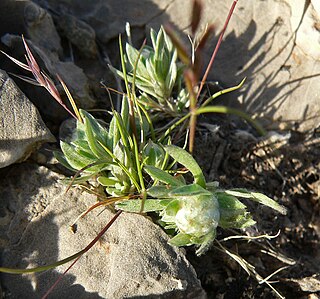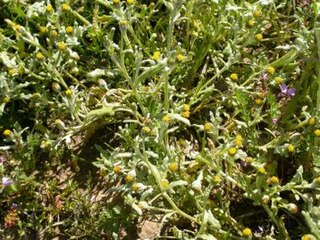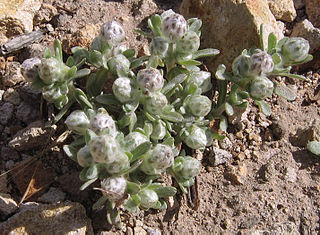
Stylocline(neststraw) is a small genus of North American desert plants in the tribe Gnaphalieae within the family Asteraceae.

Ancistrocarphus is a genus of flowering plants in the family Asteraceae. It contains two known species, both native to western North America. These plants are often treated as members of genus Stylocline, but they are not as closely related to Stylocline species as they are to plants of other genera, especially Hesperevax.

Monolopia congdonii is a rare species of flowering plant in the family Asteraceae known by the common name San Joaquin woollythread. It is endemic to California, where it is known only from the southern San Joaquin Valley and one area in nearby Santa Barbara County. It is a federally listed endangered species.

Arctostaphylos osoensis is a species of manzanita known by the common name Oso manzanita. It is endemic to San Luis Obispo County, California, where it is known from only two occurrences on the northern edge of the Los Osos Valley.

Arctostaphylos pajaroensis is a species of manzanita known by the common name Pajaro manzanita. It is endemic to California, where it is known mainly from Monterey County.

Brickellia incana is a North American species of flowering plant in the daisy family known by the common name woolly brickellbush. It is native to the Mojave Desert and Sonoran Desert in the southwestern United States, in California, Nevada, and Arizona.

Ceanothus roderickii is a rare species of shrub in the family Rhamnaceae known by the common name Pine Hill ceanothus. It is endemic to western El Dorado County, California, where it grows in the chaparral and woodlands of the Sierra Nevada foothills, such as the Pine Hill Ecological Reserve. It is named after 20th century California flora explorer, botanist, and arboretum director Wayne Roderick.

Stenotus is a genus of flowering plants in the daisy family, Asteraceae. There are four species, all native to western North America. They are known commonly as mock goldenweeds.

Monolopia major is a species of flowering plant in the family Asteraceae known by the common name cupped monolopia.
Monolopia stricta is a species of flowering plant in the family Asteraceae known by the common name Crum's monolopia. It is endemic to central California, where it grows in the Central Valley and its flanking mountain ranges and foothills. It open grasslands and chaparral, often in clay soils. It is an annual herb producing a slender, sometimes branching stem up to about 80 centimeters tall. It is usually somewhat woolly in texture. The inflorescences at the ends of stem branches bear small hemispheric flower heads. The golden ray florets are usually about 1 to 2 centimeters long, but specimens from the western San Joaquin Valley have smaller florets.
Pseudobahia bahiifolia is a rare species of flowering plant in the family Asteraceae known by the common name Hartweg's golden sunburst.
Pseudobahia peirsonii is a rare species of flowering plant in the family Asteraceae known by the common names San Joaquin adobe sunburst and Tulare pseudobahia. It is endemic to California, where it is known from a few mostly small occurrences along the southeastern side of the San Joaquin Valley where it rises into the Sierra Nevada foothills. It grows in grassland and oak woodland habitat. It prefers heavy adobe clay soils. The plant became a federally listed threatened of the United States in 1997.

Psilocarphus brevissimus is a species of flowering plant in the family Asteraceae known by the common names short woollyheads, woolly marbles, and woolly heads.
Psilocarphus elatior is a species of flowering plant in the family Asteraceae known by the common names tall woollyheads, meadow woollyheads and tall woolly-marbles. It is native to the Pacific Northwest in western North America from Vancouver Island, where it is known from just a few occurrences, to northern California. It grows in seasonally moist spots such as meadows, spring seeps, and vernal pools.

Stylocline gnaphaloides is a species of flowering plant in the aster family known by the common names mountain neststraw and everlasting neststraw.
Stylocline intertexta is a species of flowering plant in the family Asteraceae known by the common names Morefield's neststraw and Mojave neststraw. It is native to the Mojave and Sonoran Deserts of California, Nevada, Utah, and Arizona, where it grows in rocky, sandy desert soils. It likely evolved as a hybrid between woollyhead neststraw and baretwig neststraw ; it is a mix of their morphological traits and it occurs alongside both of them. It reproduces itself, producing fertile offspring, and it meets other criteria for any other definition of a species, so it was described to science as such in 1992. It is a small annual herb growing at ground level and reaching just a few centimeters in length. It is usually coated in white hairs, often woolly. The small, pointed leaves are oval to lance-shaped and measure up to 1.5 centimeters long. The inflorescence bears spherical flower heads each a few millimeters in diameter. The head has no phyllaries, just a ball of tiny woolly white flowers.
Stylocline masonii is an uncommon species of flowering plant in the family Asteraceae known by the common name Mason's neststraw.

Stylocline micropoides is a species of flowering plant in the family Asteraceae known by the common names woollyhead neststraw, woollyhead fanbract and desert neststraw. It is native to the southwestern United States and northern areas in the northern states of Mexico, where it grows in desert habitat and other dry areas. It is a small annual herb growing at ground level with stems up to 20 centimeters in length. It is woolly or felt-like in texture with a coating of white hairs. The pointed leaves are up to 2 centimeters long and alternately arranged. The inflorescence bears spherical flower heads no more than a centimeter in diameter. The head generally has no phyllaries, or has small ones that fall away early. It contains several woolly white flowers.

Stylocline psilocarphoides is a species of flowering plant in the family Asteraceae known by the common names baretwig neststraw and Peck's neststraw. It is native to the western United States from Idaho to southeastern California, where it grows in deserts and other dry, sandy, gravelly habitat. It is a small annual herb growing at ground level with stems measuring 1 to 18 centimeters in length. It is woolly or felt-like in texture with a coating of white hairs. The pointed leaves are up to 1.8 centimeters long and alternately arranged. The inflorescence bears oval flower heads no more than half a centimeter in diameter. The head generally has no phyllaries, or has small ones that fall away early. It is a hardened ball of several woolly white flowers.

Ancistrocarphus filagineus is a North American species of flowering plants in the family Asteraceae, known by the common names woolly fishhooks and hooked groundstar. It is native to western North America, including Idaho, Oregon, Nevada, California, and Baja California.













